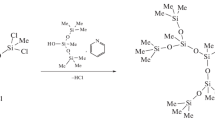Three different original protocols for the synthesis of siloxane dendrimers have been described. However, after appearing in the literature at much the same time they did not result in any follow-up, unlike many other strategies proposed simultaneously or even later. To appreciate the suddenness of the introduction of siloxane dendrimers and the reasons for their subsequent neglect we need to make an excursion into orga-nosiloxane chemistry. Silicones are based on a relatively small number of starting functional monomers. Moreover, their combination into new structures is restricted by the reversibility of most reactions and as a consequence by the statistical character of the main methods for the synthesis of siloxane polymers [1–3]. Although the existence of some selectivity results in the formation of useful polycyclics, the possibilities of structural control of linear and especially of branched oligomers and polymers are seriously limited. The nonequilibrium polymerization of strained cyclosiloxanes [4] is a rare exception to this rule which emphasizes the hopelessness of attempts to overcome the “statistical ill fate” that haunts the siloxane structures. All efforts to apply heterofunctional processes to achieve structural diversity are limited by this specificity of the siloxane bond and by a scanty number of appropriate reagents.
Because of this, it is not surprising that after the discovery of sodiumoxyorganoalkoxy-silanes, compounds unique in their synthetic versatility and often called Rebrov's salts [5], the branched functional oligomers and acyclic methylsilsesquioxanes came into the focus of our research attention. Furthermore, most of the oligomers obtained using this approach became the first generations of the corresponding dendrimers, but only after the finding of an appropriate method for quantitative transformation of alkoxy groups into the chlorosilyl ones, and a way to reiteratively use them in pairs did it become evident that possibilities of the new approach for dendrimer synthesis were enormous (see Chapter 1). By that time, dendrimers had become well known in the field of organic polymers, largely due to the efforts of D. Tomalia [6, 7].
Access this chapter
Tax calculation will be finalised at checkout
Purchases are for personal use only
Preview
Unable to display preview. Download preview PDF.
Similar content being viewed by others
References
Bazant V, Chvalovsky V, et al. (1965) Organosilicon Compounds. Academic, New York.
Andrianov KA (1965) Metalloorganic Polymers. Wiley, New York.
Fleming I (1984) Organic Silicon Chemistry in Comprehensive Organic Chemistry, Part 3. Pergamon, New York.
Boileau S (1980) Am Chem Soc Polym Prepr 21, 1:25.
Rebrov EA, Muzafarov AM, et al. (1988) Doklady Chemistry USSR 302, 2:346.
Tomalia DA, Baker H, et al. (1986) Macromolecules 19:2466.
Tomalia DA, Hall M, et al. (1987) JACS 109:1601.
Muzafarov AM, Rebrov EA, et al. (1989) Doklady Chemistry USSR 309, 2:376.
Tomalia DA (1984) 1st International Polymer Conference Society of Polymer Science. Kyoto, Japan.
Tomalia DA, Baker H, et al. (1985) Polym J (Tokyo) 17:117.
Muzafarov AM, Rebrov EA, et al. (1991) Usp Khim 60:1596.
Rebrov EA, Muzafarov AM (2006) Heteroatom Chem 17, 6:514.
Uchida H, Kabe Y, et al. (1990) JACS 112, 19:7077.
Uchida H, Kabe Y, et al. (1991) Kao Corp JP 03263431 (Chem Abstr 116:236379).
Uchida H,Yoshino K, et al. (1991) Kao Corp JP 03263430 (Chem Abstr 116:130381).
Morikawa A, Kakimoto MA, et al. (1991) Macromolecules 24:3469.
Morikawa A, Kakimoto MA, et al. (1992) Polym J 24:573.
Roovers J (1993) Macromolecules 26:4324
Muzafarov AM, Gorbatsevich OB, et al. (1993) Polym Sci 35:1575.
Frey H, Lorenz K, et al. (1996) Macromol Symp 102:19.
Frey H, Mühlhaupt R, et al. (1995) Polym Mater Sci Eng 73:127.
Voronkov MG, Mileshkevich VP (1976) Siloxane Bond. Nauka, USSR.
Krasovskii VG, Sadovskii NA, et al. (1994) Polym Sci Ser A 36:589.
Krasovskii VG, Ignat'eva GM, et al. (1996) Polym Sci Ser A 38:1070.
Ponomarenko SA, Rebrov EA, et al. (1996) Liq Cryst 21:1.
Ponomarenko SA, Rebrov EA, et al. (1998) Polym Sci Ser A 40:763.
Richardson RM, Ponomarenko SA, et al. (1999) Liq Cryst 26:101.
Shumilkina NA, Myakushev VD, et al. (2005) Doklady Chem USSR 403:155.
Shumilkina NA, Myakushev VD, et al. (2006) Polym Sci Ser A 48, 12:1240.
Ignat'eva GM, Rebrov EA, et al. (1997) Polym Sci Ser A 39:843
Brüning K, Lang H (1998) J Organomet Chem 571:145.
Kim C, Kwon A (1998) Synthesis 105.
Kim C, Jeong Y, et al. (1998) J Organomet Chem 570:9.
Brüning K, Lang H (1999) Synthesis 1931.
Muzafarov AM, Golly M, et al. (1995) Macromolecules 28:8444.
Dvornic PR (2006) J Polym Sci Part A Polym Chem 44:2755.
Dvornic PR, de Leuze-Jallouli AM, et al. (2000) Macromolecules 33:5366.
de Leuze-Jallouli AM, Swanson DR, et al. (1997) Polym Mater Sci Eng 77:67.
Dvornic PR, Hu J, et al. (2002) Silicon Chem 1:177.
Bystrova AV, Tatarinova EA, et al. (2005) Polym Sci Ser A 47, 8:820.
Bystrova AV, Tatarinova EA, et al. (2007) Science and Technology of Silicones and Silicone-Modified Materials. ASC Symposium Series 964. ISBN10: 0841239436
Bystrova AV, Parshina EA, et al. (2007) Nanotechnol Russ 2, 1:83.
Tereshchenko AS, Getmanova E V, et al. (2007) Russ Chem Bull Intern Edit 56:2200.
Getmanova E V, Tereshchenko AS, et al. (2004) Russ Chem Bull Intern Edit 53, 1:137.
Obreskova MV, Rogul' GS, et al. (2008) Doklady Chem 419, 1:69.
Hawker CJ, Malmstrom EE (1997) JACS 119:9903.
Chojnowski J, Cypryk M (2003) Macromolecules 36:3890.
Kazakova V V, Rebrov EA, et al. (2000) Silicones and Silicone-Modified Materials. ACS Symposium series 792:503. ISBN 0-8412-3613-5.
Voronina N V, Meshkov IB et al. (2008) Nanotechnol Russ 3, 5–6:321.
Author information
Authors and Affiliations
Editor information
Editors and Affiliations
Rights and permissions
Copyright information
© 2009 Springer Science + Business Media B.V.
About this chapter
Cite this chapter
Muzafarov, A., Rebrov, E. (2009). Polysiloxane and Siloxane-Based Dendrimers. In: Dvornic, P.R., Owen, M.J. (eds) Silicon-Containing Dendritic Polymers. Advances in Silicon Science, vol 2. Springer, Dordrecht. https://doi.org/10.1007/978-1-4020-8174-3_2
Download citation
DOI: https://doi.org/10.1007/978-1-4020-8174-3_2
Publisher Name: Springer, Dordrecht
Print ISBN: 978-1-4020-8173-6
Online ISBN: 978-1-4020-8174-3
eBook Packages: Chemistry and Materials ScienceChemistry and Material Science (R0)




